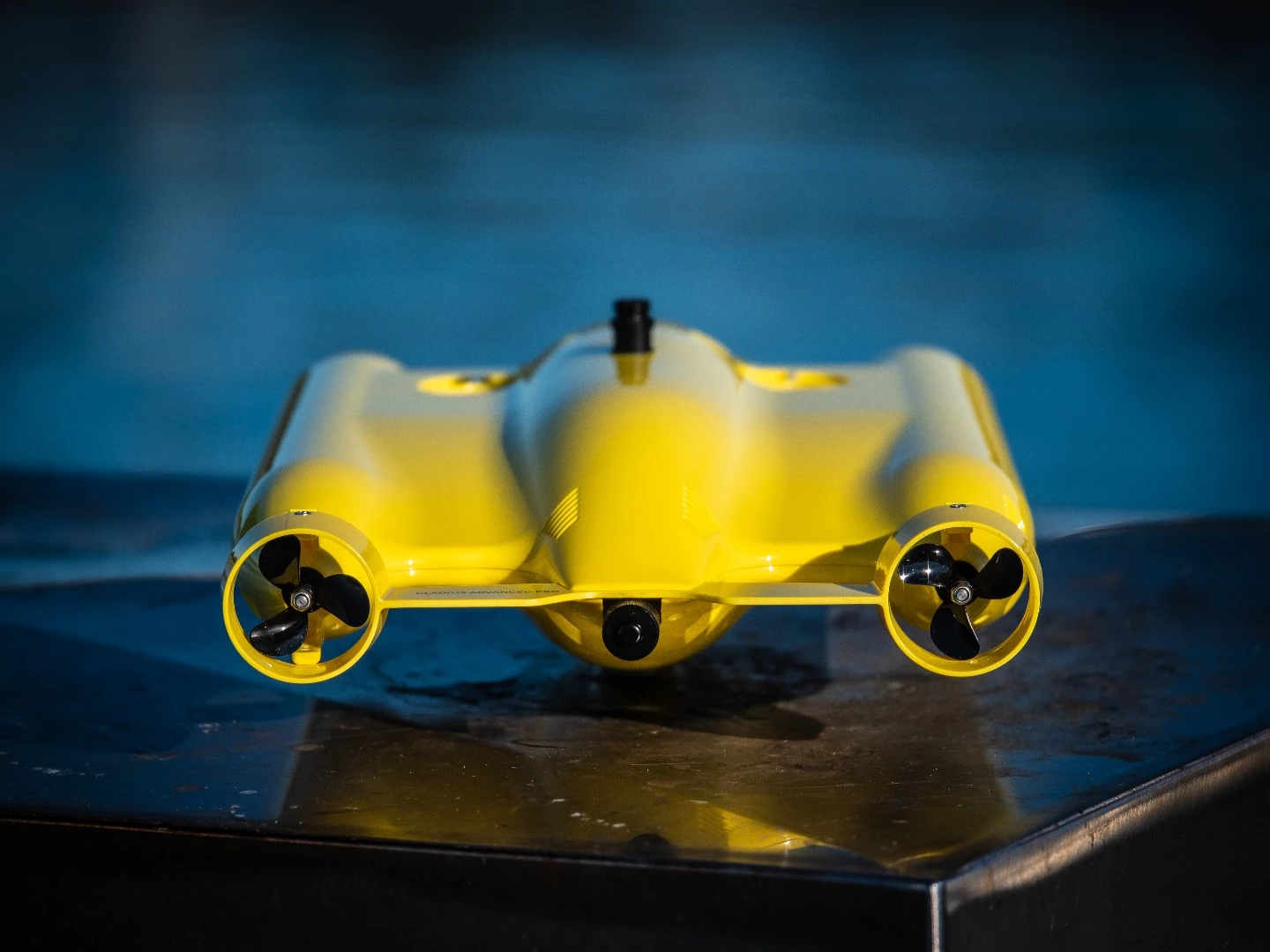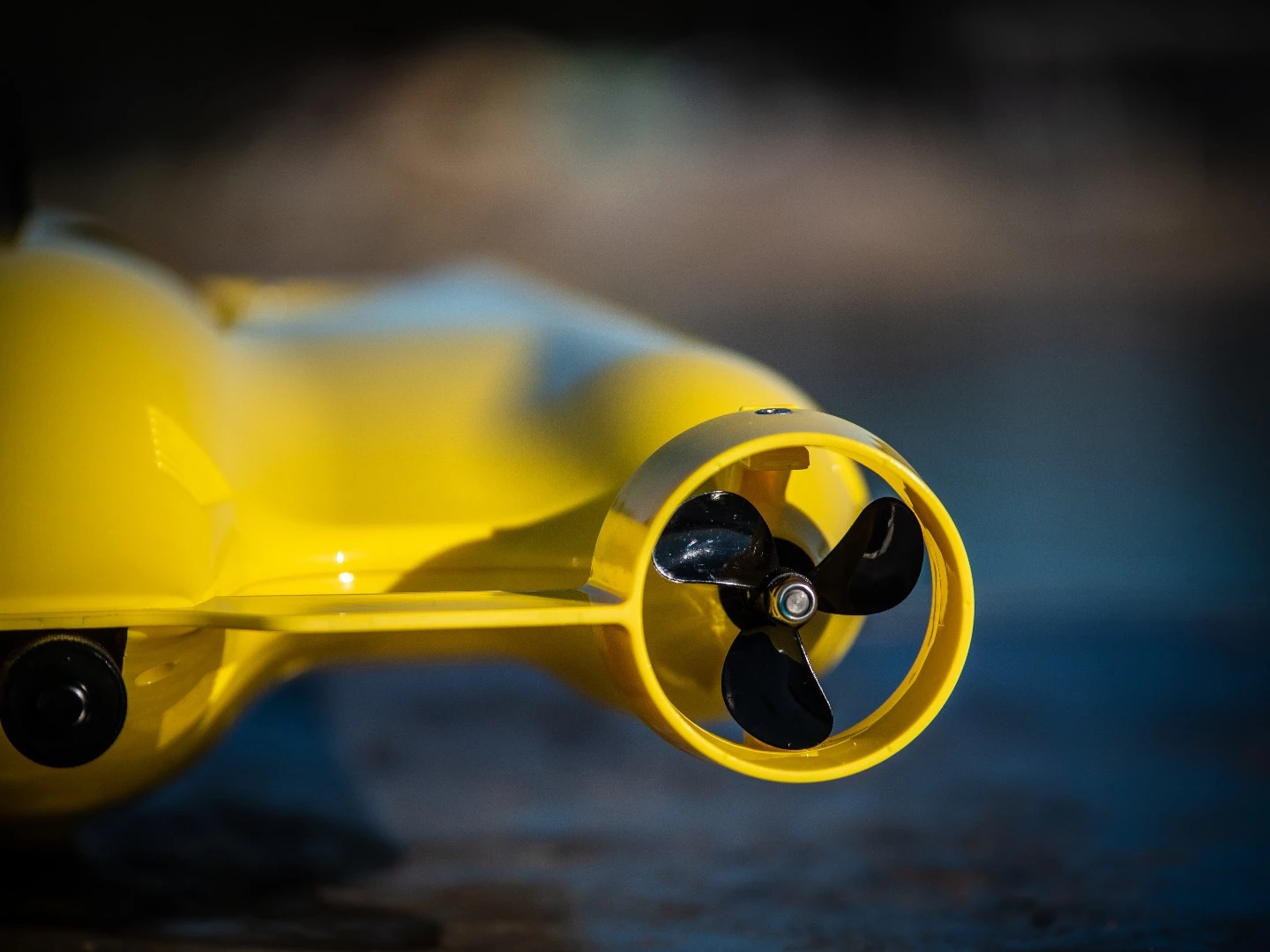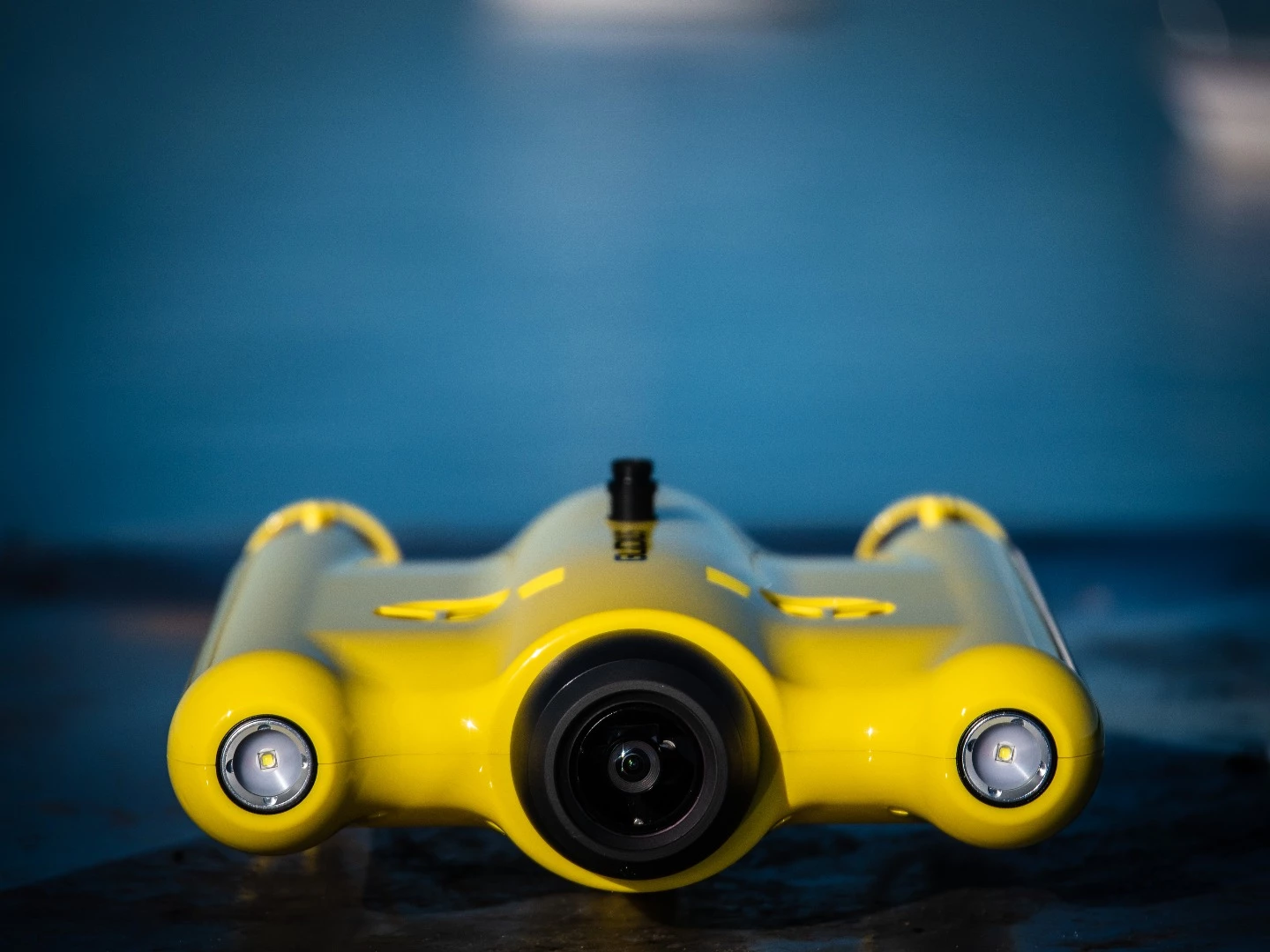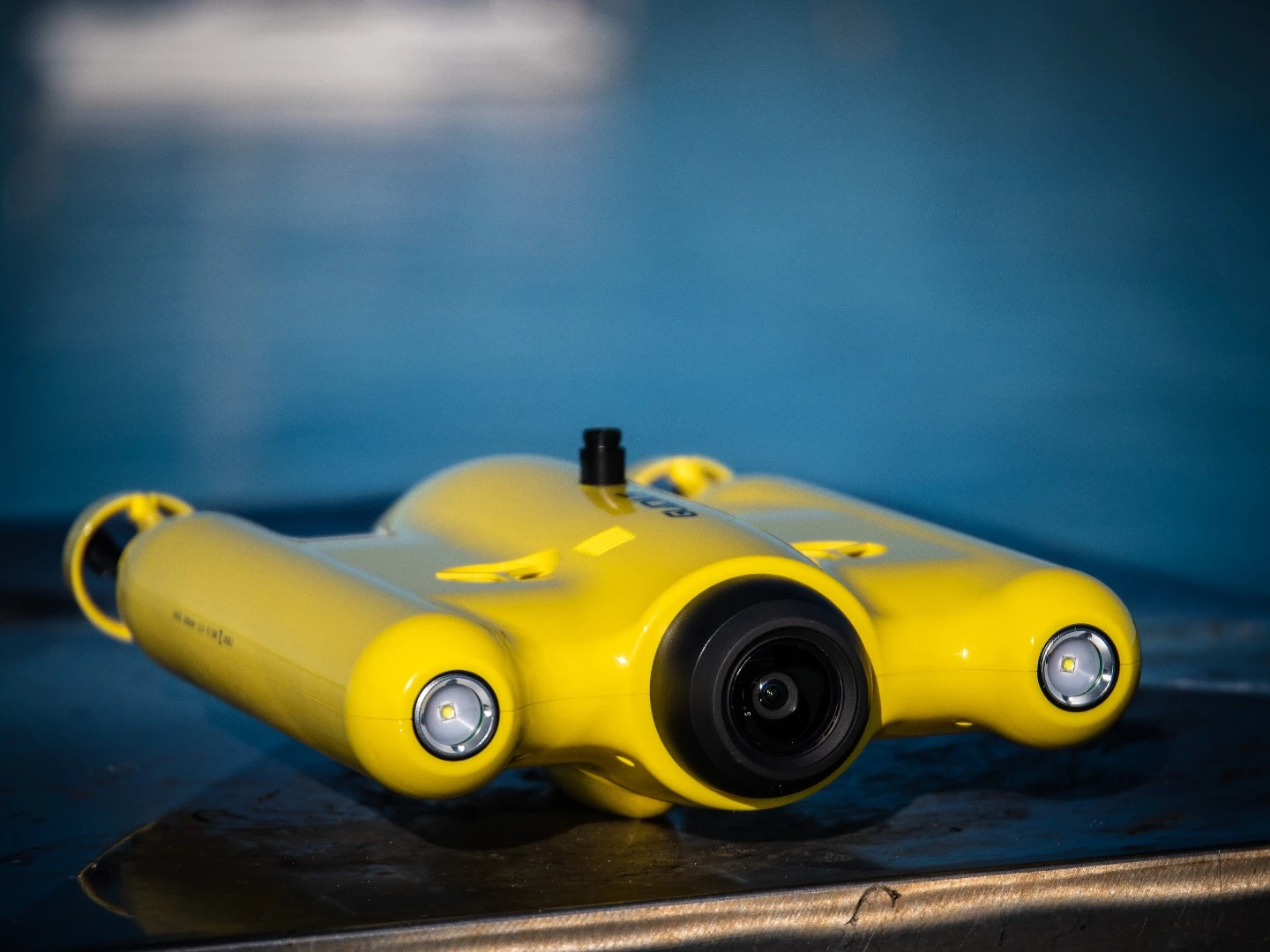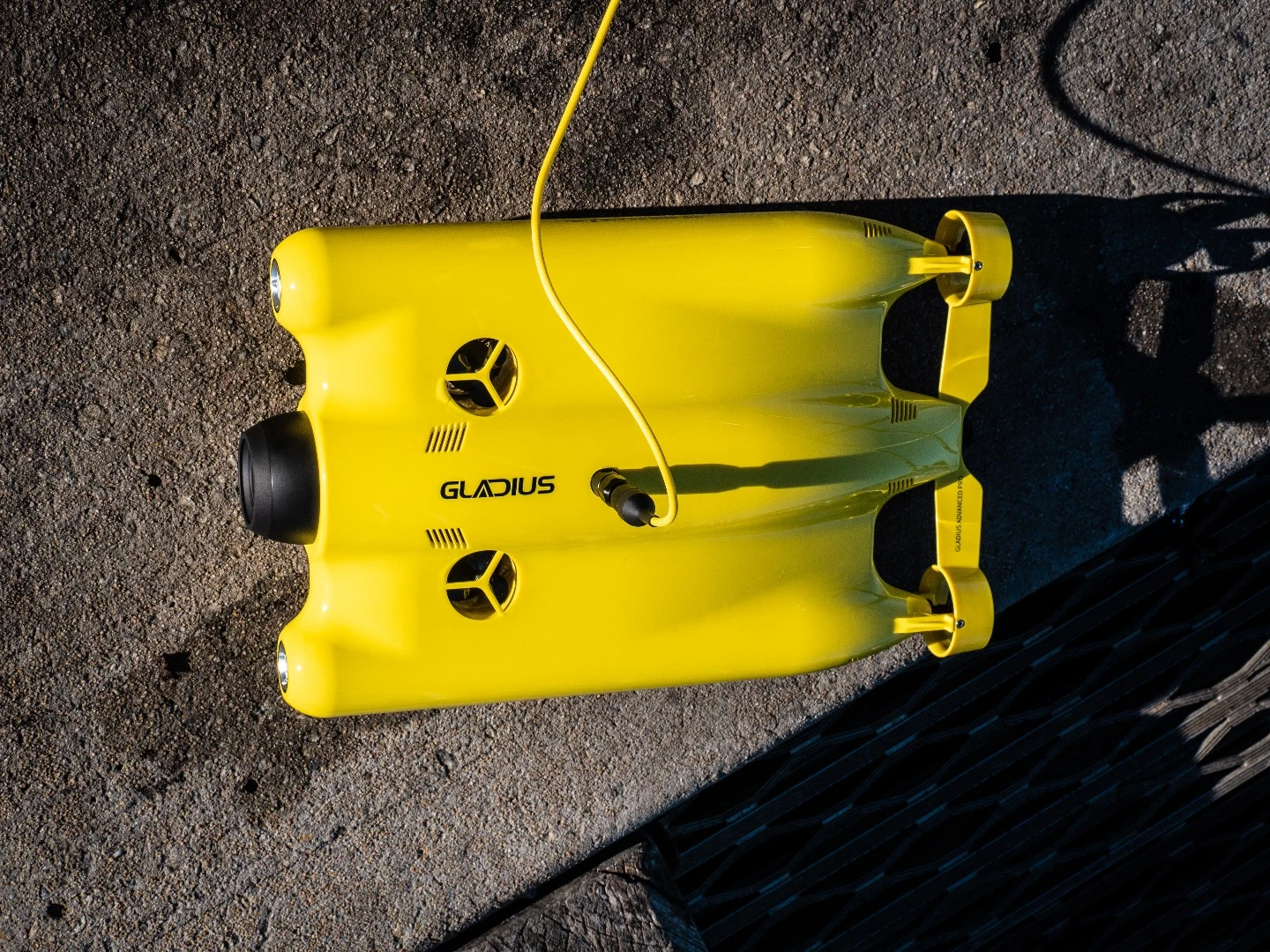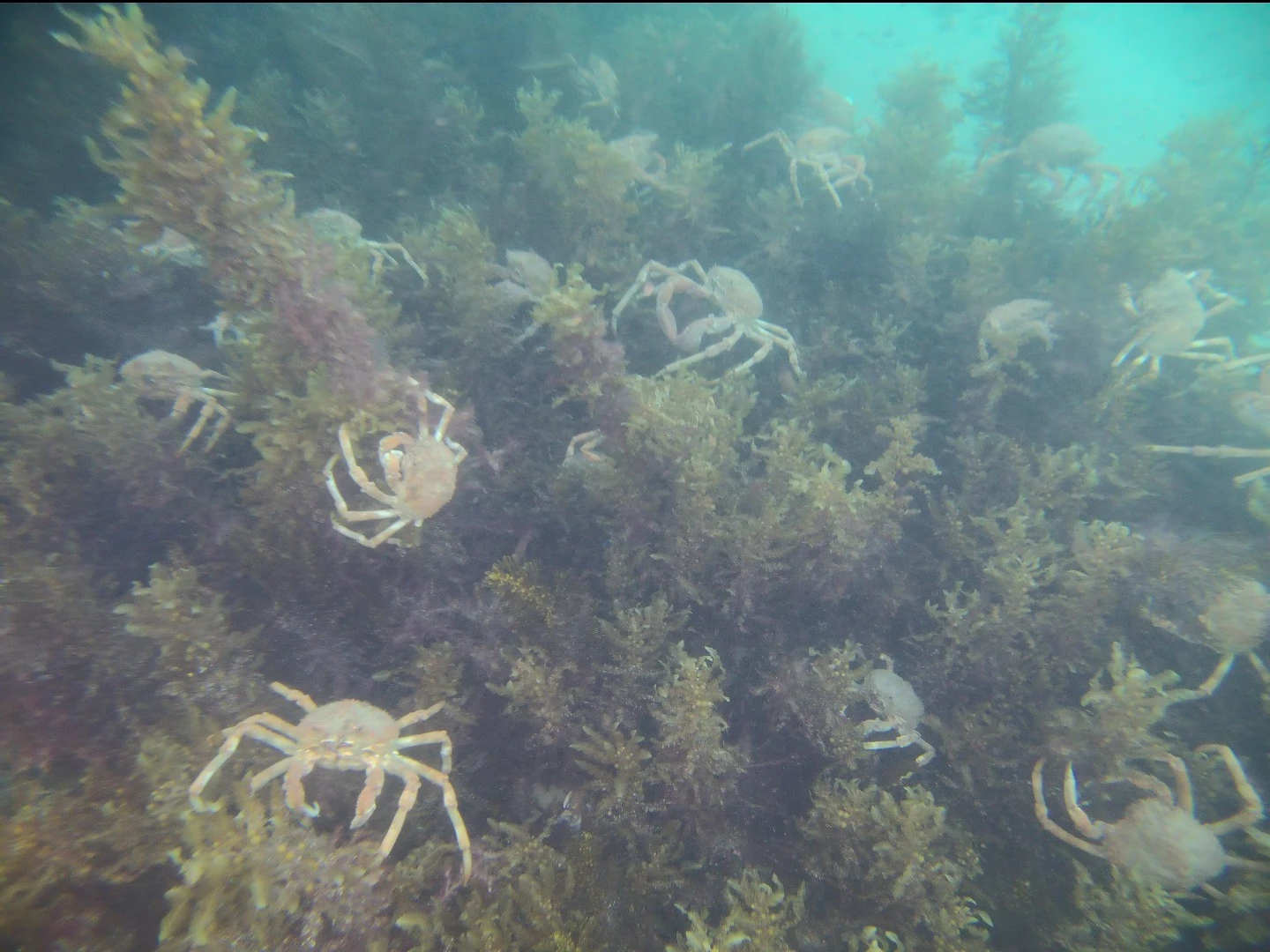Underwater drones are starting to become more popular, and the Gladius is one of the better-specified ones you'll find. Capable of diving for over four hours, to depths of 330 ft (100 m), with a 4K camera and 2,400-lumen spotlights, it makes for some fascinating underwater exploration.
Flying camera drones have only been about for a few short years, but as recent drone photography contests would attest, they've already done a magnificent job of opening up new perspectives. Now, there's a growing market of underwater drones that aim to do the same thing for the aquatic perspective.
Underwater drones have certain advantages; the ability to control buoyancy can make them much more energy-efficient than aerial drones, which need to constantly expend energy to stay aloft. So underwater drones can get a ton more run-time out of a battery, which is lucky, because you sure don't want to be changing charged batteries on a dripping wet drone.
On the downside, wireless Bluetooth and Wi-Fi signals can't get through water, so pretty much any consumer underwater drone is going to need to run on a tether cable, and those can get messy if you're giving them a decent range.
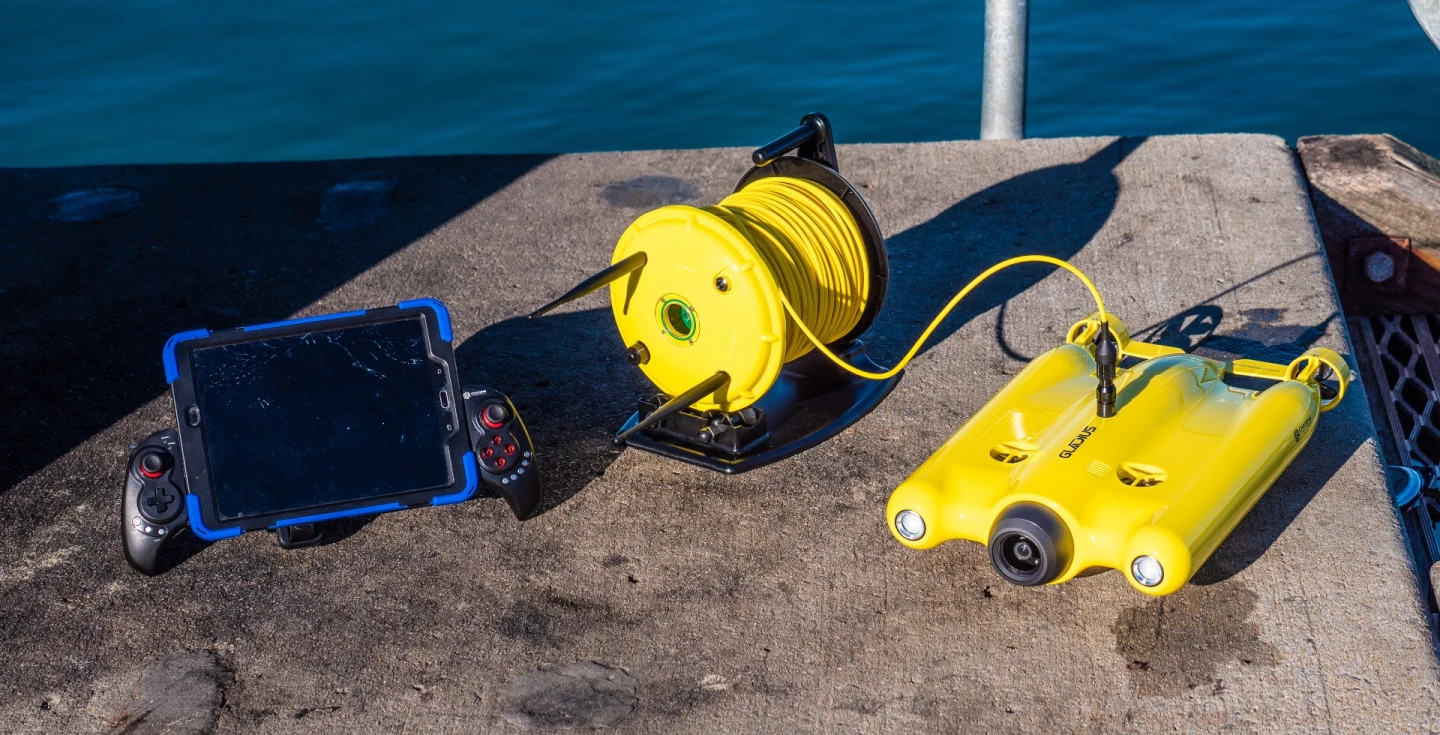
The Gladius Advanced Pro, by Chinese company Chasing Innovation, is the first underwater drone I've had a chance to play with. It's the top unit in the Gladius line, with a 4K camera, 64 GB of built-in storage, 2,400 lumens of LED lighting, and a remarkable maximum depth of 328 ft (100 m).
It's a fair bit bulkier than a consumer-grade aerial drone, but you can carry the Gladius around in a backpack, while its tether station lives in a separate shoulder bag. The combined weight is up around 5 kg (11 lb), so it's a decent weight to lug about.
Setup is reasonably quick. You plug the drone into the tether, turn on the tether station to set up a Wi-Fi network, then slot your phone or tablet into the controller, connect to the Wi-Fi and you're ready to go. You may need to remember a Phillips head screwdriver to make sure you've got the right ballast weight on, depending on whether you're operating in fresh or seawater. All the ports on the drone and the tether station are fitted with waterproofing caps, so you need to make sure you don't lose those.
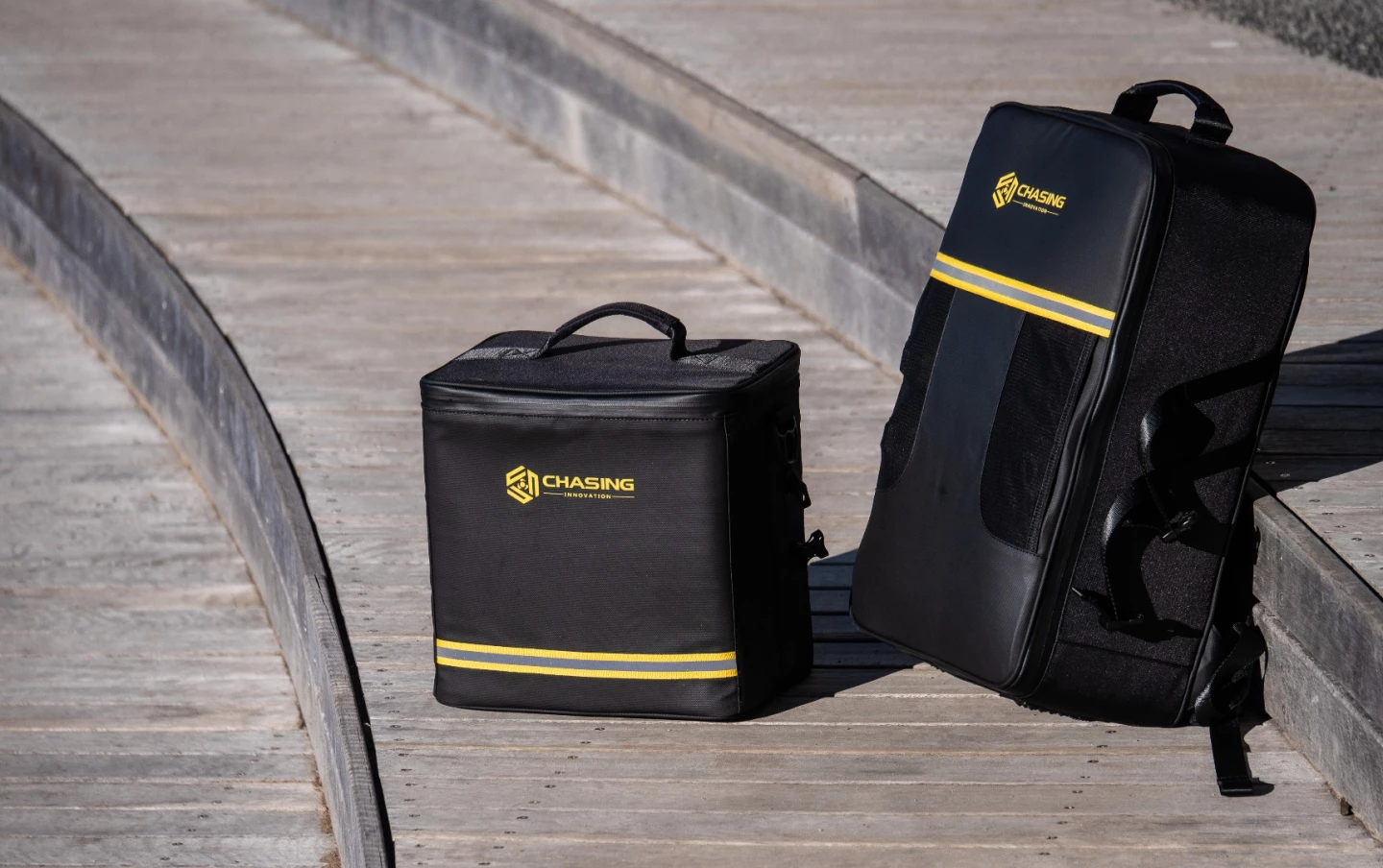
From there, you lower the drone into the water. Dangling it on the tether cable feels like a bad idea, but you needn't worry, as it's rated to carry 100 kg (220 lb) without breaking. You unspool and throw out as much tether as you think you'll need, and the Gladius bobs around in the water until you open up the IF.Dive app on your screen, and arm the motors ready to fly.
I say fly not just because that's how submarine designer Graham Hawkes explained underwater motion to me when I was about to test drive his Deepflight Dragon sub, but because that's really how it feels when you control the Gladius – more like flying a model aircraft than a DJI Phantom.
The left stick controls the throttles, giving you forward and reverse motion, and steering the drone on its yaw axis. The right stick controls tilt, allowing you to aim the nose up and down and roll the craft left and right. So there's no facility to simply have the drone pull itself straight downward to submerge, you've got to point the nose down and move forward. Other buttons start/stop video recording, snap stills, control the output of the LED forward lights, and engage/disengage a stabilizer mode that I preferred to leave off.
As somebody who doesn't go snorkeling, and who has only been under once with scuba gear, I was amazed by just how much is going on under the surface. My first flight was off the pier at Blairgowrie in Victoria, where I'd been told the spider crabs were out in force. No kidding! There were thousands of the little guys under there, wandering about and snacking on seaweed.

Just as I was getting eye to eye with a few hundred crabs, a giant shadow passed beneath me – a sting ray as wide as my outstretched arms, rippling its way hypnotically along past my camera. I spun the drone around and gave chase. "They come in to feed on the crabs," came a voice from over my shoulder, and I turned around to realize three or four people had stopped to watch the vision on my screen. That became a theme wherever I flew the Gladius – these things are as much of a curiosity to passers-by as aerial drones were when they first started appearing.
Mind you, they're nowhere near as problematic. Try to land a drone when a group of people has gathered around, and you're almost certainly going to have to break some laws or tell people to move. With an underwater drone, it's the more the merrier, nothing's going to fall on anyone's head. And it's easy enough to operate that I was able to let my four-year-old take the sticks for a few minutes. Sick of always watching and never getting a chance to fly the other drones I bring home, he was absolutely thrilled to fly this thing.
Once it's underwater and out of sight, it can be hard to tell what the heck's going on by looking at the screen. If the water's not crystal clear, all you can see is blue a lot of the time, until you get down close to the sea bed or approach the surface. And if you reach the end of the tether wire and start pulling on the spool, that can tug the drone in all sorts of directions.
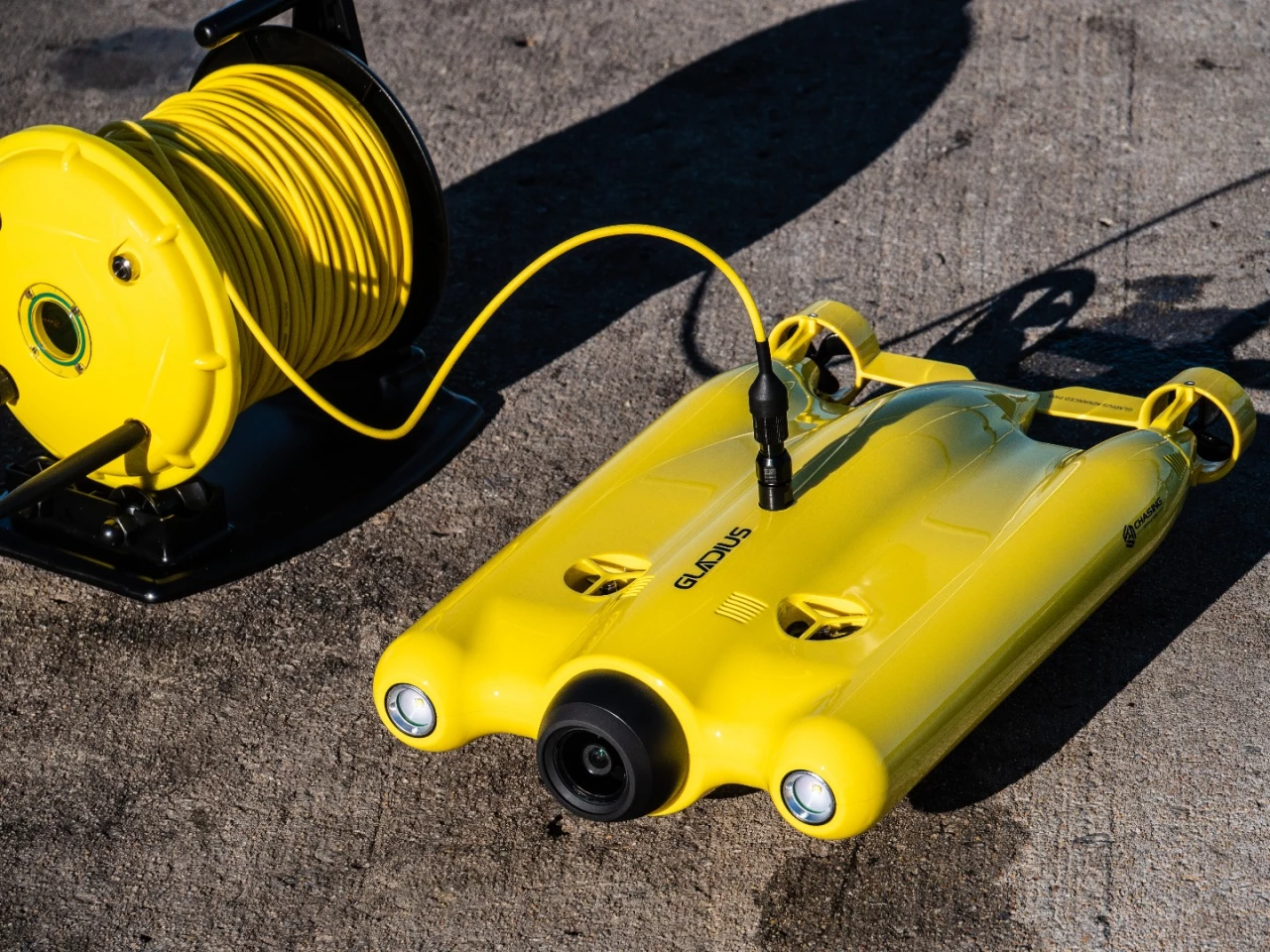
Luckily, there's an orientation meter on the control screen, a 3D model of the Gladius that shows which way it's pointed. So even if you can't tell where the drone is under the water, at least you know which direction it's pointed. Want to find the sea bed? Point it down and go. Once it's time to come up, you can point it upward and throttle on, confident that you'll get a visual on its bright lights it when it surfaces.
Unfortunately, I didn't get the chance to fly the Gladius in very clear water, so the footage I captured probably doesn't show the camera in a great light. And that's a pity, because I think it's actually a decent little unit capable of a GoPro-equivalent image. But it's the middle of a windy, rainy winter in my part of the world, so the water was murky and I needed the spotlights on full power most of the time. I'd have loved to take it to somewhere tropical, with clear water and coral to look at, but didn't have the chance.
The Gladius is easy to fly, but hard to be precise with. That makes it great for exploring, zooming around on the ocean floor checking things out. But once you find something, keeping it in frame and setting up a nice shot can be pretty difficult. The currents move you about, making your footage look a bit drunk. You've got a very limited ability to move sideways, so you're stuck trying to hold yourself as still as you can or moving forwards. And the twin 1,200-lumen lights either side of the camera do a great job of illuminating what's right in front of you, but they also give the footage a bit of a stark, "built-in flash" kind of look.
For these reasons, I can't see something like this becoming a substitute for an underwater cameraman. Being underwater, hand-holding a GoPro or some better camera will still likely net you better footage if that's your goal. On the other hand, throwing the Gladius out of the boat to do some exploration is a lot quicker than suiting up for a dive, and you can fly it regardless of whether there are sharks in the area, for example.
Getting it out of the water's much the same as putting it in – you lift it out by the tether cable after disarming the motors. At this point, you're more or less stuck waiting for it to dry off before you can put it away. Rolling up the tether cable can be a bit of a pain, and you've got to make a call on when you think things are dry enough to disconnect the cable, making sure you don't let any water into the contacts before getting the rubber caps back on. I'd recommend bringing a towel, because if you put either the drone or the tether roll away soggy in their little watertight bags within the backpack and carry bag, they'll stay soggy until the next time you get them out.

Battery life simply wasn't a consideration for me. At 30 percent throttle with the lights off, it'll run for 4.5 hours. Likewise, the 64 GB of onboard storage means you don't need to worry about SD cards. On the other hand, getting footage out into the real world is a bit of a pain. You've got to reconnect the drone to the tether station when you get home, then transfer what ends up being several gigabytes of footage to your phone or tablet, then upload them again to your PC wirelessly if your phone doesn't do removable storage.
It's an actively aggravating process that can take hours depending on your network speeds, and it fills up your devices with annoyingly large video files – although I can understand the waterproofing issues it might cause to put a USB port on the drone for direct transfers. I don't have a better solution.
All in all, I think the Gladius is a pretty terrific gadget. The underwater landscape is a strange and alien one if you don't spend a lot of time diving, and this kind of device makes for fascinating fun as you explore it. My kid thinks it's deadly cool, although he also really digs leaves, so take his opinion for what it's worth. I don't see it as a better tool for cinematography than a diver holding a camera, although you can definitely get the odd keeper out of it with a bit of practice. I'd like to try taking it out on a fishing trip to see if it's got any value as a fish spotting tool. In fact, having one on your boat would make for some interesting opportunities, and flying it in clear tropical waters would be absolutely amazing.
At US$2,199, it's certainly not cheap enough to be an impulse gadget buy for most people. There's a cheaper Gladius Standard Pro for US$1,749, which films in 1080p/60fps, has a smaller 16 GB internal memory, and only goes down to 164 ft (50 m). I think I'd get similar value out of the Standard Pro; 4K footage is nice, but it's also a pain to deal with, particularly when you have to move it all wirelessly. But even that's still a fair old chunk of change. At least for your money, you're getting a well-built, seaworthy and easy-to-use unit.
You can check out some of the underwater action we captured in the video below.
Source: Chasing Innovation

